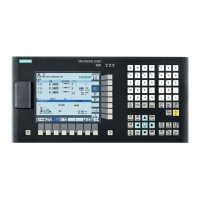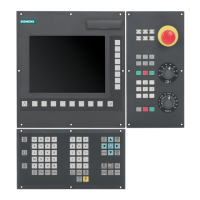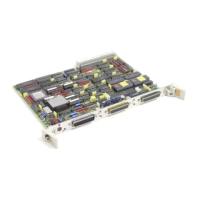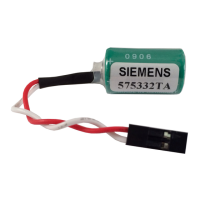Programming and Operating Manual (Milling)
6FC5398-4DP10-0BA6, 09/2017
79
Program structure
Structure and content
The NC program consists of a sequence of
(see the table below). Each block represents a machining step.
Instructions are written in the blocks in the form of
. The last block in the execution sequence contains a special word
for the end of the program,
for example,
.
The following table shows you an example of the NC program structure.
Block N20 G2 Z37 ... ; Second block
Block N30 G91 ... ... ; ...
Block N50 M2 ; End of program
Programming instructions
11.2.1
In this section you will find descriptions of the commands, with which you can directly program dimensions taken from a
drawing. This has the advantage that no extensive calculations have to be made for NC programming.
The commands described in this section stand in most cases at the start of an NC program. The way, in which these
functions are combined, is not intended to be a patent remedy. For example, the choice of working plane may be made at
another point in the NC program. The real purpose of this and the following sections is to illustrate the conventional struct
of an NC program.
Overview of typical dimensions
The basis of most NC programs is a drawing with concrete dimensions.
When implementing in a NC program, it is helpful to take over exactly the dimensions of a workpiece drawing into the
machining program. These can be:
● Absolute dimension, G90 modally effective applies for all axes in the block, up to revocation by G91 in a following block.
● Absolute dimension, X=AC(value) only this value applies only for the stated axis and is not influenced by G90/G91. This
is possible for all axes and also for SPOS, SPOSA spindle positionings, and interpolation parameters I, J, K.
● Absolute dimension, X=DC(value) directly approaching the position by the shortest route, only this value applies only for
the stated rotary axis and is not influenced by G90/G91. This is also possible for SPOS, SPOSA spindle positionings.
● Absolute dimension, X=ACP(value) approaching the position in positive direction, only this value is set only for the rotary
axis, the range of which is set to 0... < 360 degrees in the machine data.
● Absolute dimension, X=ACN(value) approaching the position in negative direction, only this value is set only for the
rotary axis, the range of which is set to 0... < 360 degrees in the machine data.
● Incremental dimension, G91 modally effective applies for all axes in the block, until it is revoked by G90 in a following
block.

